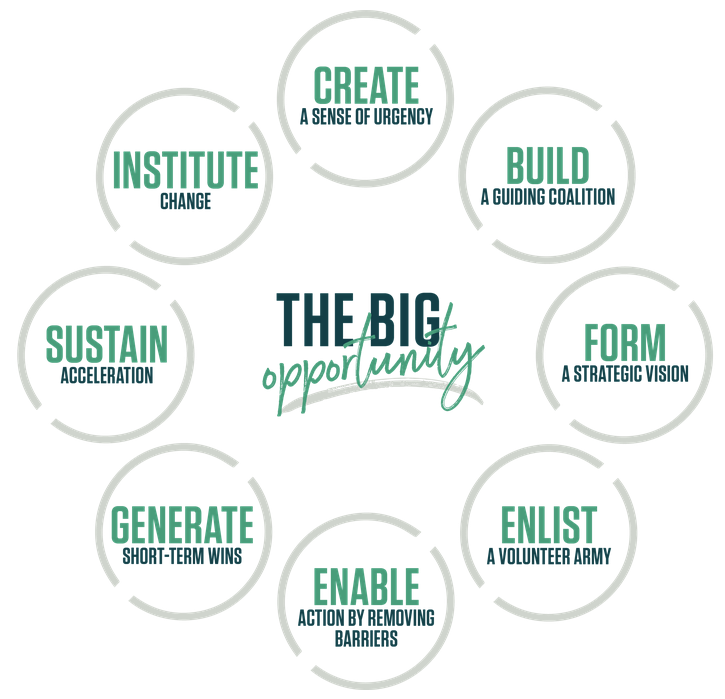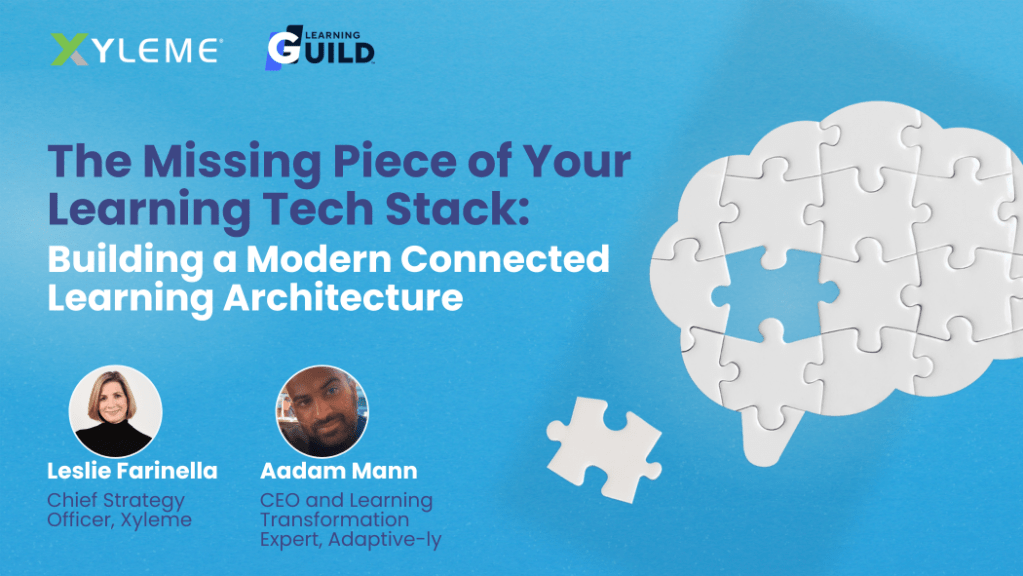Learning and Development leaders, particularly within large enterprises, are often at the forefront of ushering in change. Whether it’s in the form of new learning technologies, evolving content strategies, or shifts in educational paradigms, change demands acknowledgment and adept management. The challenge? Effectively navigating the intricate process of change management.
We’re not just talking about any change but transformational change—the kind that reshapes how your organization approaches learning and development at its core. A thoughtful, systematic approach is critical for success, and too often, companies spend too little time socializing and evangelizing why change is necessary, let alone how it will happen.
Before embarking on your change-management journey, you need to:
- Gain insights into the proven strategies that work, like Kotter’s 8-Step Change Model and Lewin’s Change Management Model
- Develop an understanding of the common challenges you may encounter
- Learn from real-world case studies about the successful—and not-so-successful—change-management efforts.
But at the heart of all this is a trio of essentials – empathy, communication, and the ability to listen. These are the three pillars of successful change management.
Understanding the Need for Change in L&D
Change in the learning and development sector, especially within large enterprises, is inevitable and essential. The L&D landscape is continually evolving, driven by technological advancements, changing workforce demographics, and the ever-increasing need for upskilling and reskilling.
Recognizing and responding to these shifts is about more than just staying relevant. L&D is leading the charge in shaping a future-ready workforce.
There’s an increasing emphasis on personalized learning experiences tailored to diverse employee needs and learning styles. Rapid industry transformation is another crucial driver, pushing organizations to adopt more tech-centric approaches to training and development. And then there’s the changing nature of work itself – the shift to remote or hybrid models, the rise of gig work, and the continuous evolution of job roles.
Aligning these changes with your organization’s overarching goals and culture is more than introducing new tools or content. Understanding the unique dynamics of your organization and its people is the only way to craft a change strategy that resonates and sticks successfully. This alignment is crucial because management in L&D is about people – helping them adapt, grow, and thrive in the face of change.
Critical Strategies for Effective Change Management
A strategic approach to change is paramount. Two renowned change management models are adaptable to the unique needs of the L&D sector.
Kotter’s 8-Step Change Model offers a comprehensive step-by-step approach:
- Create a sense of urgency
- Form a guiding coalition
- Develop a vision and strategy
- Communicate the vision for change
- Empower people for broad-based action
- Generate short-term wins
- Build on the change
- Embed the changes into your organizational culture.
These steps can be tailored to address specific L&D goals, such as integrating new learning technologies or methodologies, enacting content governance, or shifting how and when you deliver learning content.
Lewin’s Change Management Model is a more straightforward, yet effective model that involves three stages:
- Unfreeze
- Change
- Refreeze

The “unfreeze” stage in an L&D context, could involve challenging the current state of your L&D programs and preparing for a shift. The “change” stage is where the actual implementation of new methods or technologies happens. It’s crucial to support and guide your team through this transition.
Finally, the “refreeze” stage involves weaving the changes into the company’s standard operating procedures, ensuring they are sustainable and embedded into the organizational culture.
Successful change management is rooted in customization and alignment. It’s about adapting these models to fit your organization’s unique context. A one-size-fits-all approach rarely works in complex and nuanced environments.
As you put these strategies into use, remember the importance of empathy, communication, and listening. The most well-planned change initiatives can falter without a human-centric approach. Understanding the concerns and needs of those affected by the change—and maintaining open communication channels throughout the process—is vital for success.

Brad Swingruber, CRO
I’ve always been told the best time to make critical company change and digital transformation was “YESTERDAY!” We hear people say this tongue and cheek, but the reality is most organizations are paralyzed with the fear of change.
Four Common Change Management Challenges and Solutions
Change, particularly in large and complex organizations, has challenges. In the realm of learning and development, these challenges can be quite specific. Recognizing them is the first step towards devising effective solutions.
Successful change management requires patience, persistence, and a willingness to adapt.
Resistance to Change: One of the most common challenges is employee resistance. This can stem from a fear of the unknown, comfort with the status quo, or concerns about the impact of change on their roles.
To counter this, involving employees early in the change process is crucial. Communicate the reasons for the change, and how it benefits them and the broader organization. Encourage feedback and involve employees in decision-making where possible. Inclusivity can significantly reduce resistance and increase buy-in.
Technological Hurdles: Implementing new technologies or digital platforms for L&D can be daunting. Challenges can range from technical issues to a lack of digital literacy among employees.
To navigate this, provide comprehensive training and support. Ensure that employees understand how to use the new technology and its relevance and benefits. Gradual implementation, rather than a sudden shift, can also help ease the transition.
Aligning Change with Business Goals: Often, L&D initiatives may drift away from aligning with the overall business objectives. This misalignment can lead to ineffective training programs and wasted resources.
The solution lies in continuous alignment and evaluation. Regularly review your L&D strategies to ensure they are in sync with the company’s goals and make adjustments as needed.
View the Missing Piece of Your Learning Tech Stack webinar to modernize your tech stack to drive employee & customer engagement, improve learner experience & outcomes, and build a culture of continuous learning.
Measuring Impact: Another challenge is quantifying the impact of L&D changes. Without clear metrics, it’s difficult to gauge success or identify areas for improvement.
Establish clear, measurable goals at the outset. Whether it’s improved employee performance, higher engagement rates, or increased knowledge retention, having concrete metrics helps in evaluating the effectiveness of your L&D initiatives.
"We had to create a COVID-19 project very rapidly and accurately. This was just one of many times within the past couple of years in which we had to rapidly deploy something, and we were able to do it and properly customize the content because of Xyleme. The ROI has been significant for Allina!" > read more
Deborah Hardison, Allina Health
Empathy, Communication, and Listening: The Pillars of Successful Change
Successful change management initiatives share three fundamental elements: empathy, communication, and active listening. These the essential building blocks that determine the success or failure of your change management efforts.
Display genuine understanding of concerns and address them directly. Empathy is about putting yourself in the shoes of your employees and understanding their perspective. In the context of change management, it means recognizing how changes might impact their learning experience, work routine, and overall job satisfaction.
By showing empathy, you can anticipate potential resistance and address concerns proactively. It also involves being sensitive to the varying learning needs and preferences of a diverse workforce. This empathetic approach can foster a supportive environment conducive to successful change.
Communication is the bridge between vision and reality. Effective communication is the bridge that connects your change vision to its successful implementation.
Nothing tanks a change-management initiative faster than an executive webcast followed by the cascade of a slide deck in a follow-up email. You need to foster a two-way dialogue where feedback is encouraged and valued.
Transparent, clear, and consistent communication helps demystify the change process, aligns everyone’s understanding, and builds trust. Don’t just explaining the “what” and the “how” of the changes but also the “why” – the rationale behind the change and its benefits.
Active listening is a tool for engagement and improvement. Active listening goes hand-in-hand with effective communication. It involves genuinely listening to your employees’ feedback, concerns, and suggestions.
This practice helps identify potential issues early on and makes employees feel valued and involved. Active listening can lead to valuable insights that can further refine and improve your change management strategies. These three pillars can help you create a more inclusive, responsive environment for change. This human-centric approach is what ultimately drives success and ensures the sustained, engaged embrace of change.
Change Is A Journey, Not A Destination
Change management, particularly within large enterprises, is a multifaceted and dynamic process. Guiding an entire organization through a transformation journey is neither quick nor simple. However, it is possible to achieve success if you communicate the need for change, strategically apply robust change management models, effectively tackle the inevitable challenges, and learn from the successes of others.
The true cornerstone of any successful change initiative in L&D is the human element – empathy, communication, and active listening that connects leaders with their teams.
Change is inevitable, but how you manage that change sets you apart. By embracing these principles and strategies, you can ensure that your L&D initiatives are effective in the short term and sustainable and impactful in the long run.







